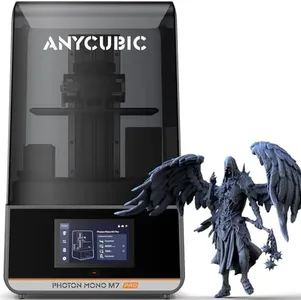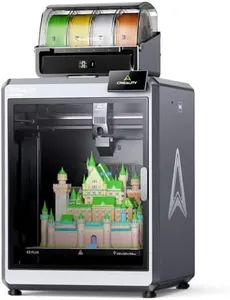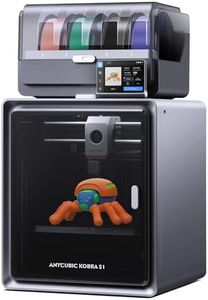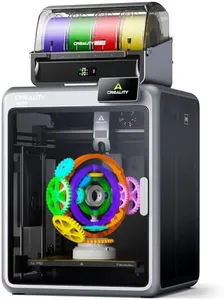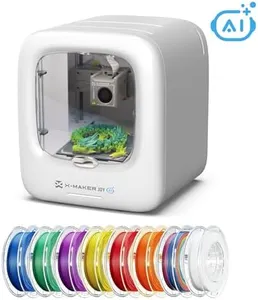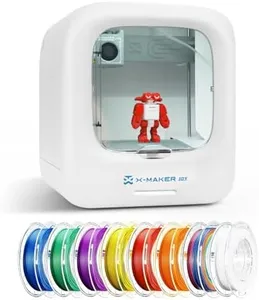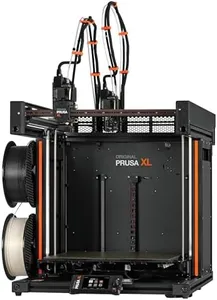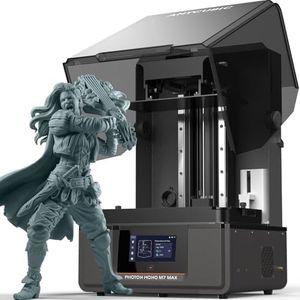10 Best 3D Printers 2025 in the United States
Our technology thoroughly searches through the online shopping world, reviewing hundreds of sites. We then process and analyze this information, updating in real-time to bring you the latest top-rated products. This way, you always get the best and most current options available.

Our Top Picks
Winner
FLASHFORGE Adventurer 5M Pro 3D Printer with 1 Click Auto Printing System, 600mm/s High-Speed, Quick Detachable 280°C Nozzle, Core XY All-Metal Structure, Multi-Functional 220x220x220mm 3D Printer
Most important from
3033 reviews
The FLASHFORGE Adventurer 5M Pro is a well-rounded 3D printer designed to cater to a wide range of users, especially those seeking a balance between speed and quality. It uses Core XY print technology with a sturdy all-metal frame that ensures stability, allowing it to print quickly—up to 600mm per second—without sacrificing detail. The build volume of 220x220x220mm is fairly standard and suits most hobbyist projects or small functional parts.
A standout feature is its ease of use: the printer includes automatic bed leveling with pressure sensing, eliminating the need for manual bed adjustments. This, combined with its quick nozzle heating (up to 200°C in 35 seconds) and a removable dual-sided PEI platform, simplifies setup and post-printing cleanup. The included mobile app provides remote monitoring and control, adding convenience for users who want to keep an eye on prints without being near the machine.
Material compatibility is broad, supporting common filaments like PLA, ABS, and PETG, plus specialty materials including TPU and carbon-fiber infused variants. The nozzle can reach up to 280°C, allowing for these diverse materials. This makes the printer versatile enough for creative projects and more durable prototype parts. The printer weighs over 30 pounds and is moderately sized, requiring some space but not being overly bulky.
This printer is well suited for users who want an easy-to-use, fast, and versatile 3D printer with smart features and good material support. It is particularly beneficial for beginners or intermediate users who value convenience and speed while maintaining good print quality.
Most important from
3033 reviews
FLASHFORGE AD5X Multi-Color 3D Printer, CoreXY 600mm/s High-Speed, 1-Click Auto Leveling, 300°C Direct Drive Extruder, 220x220x220mm Build Volume, Ideal for Precision and Efficiency
Most important from
190 reviews
The FLASHFORGE AD5X is a capable multi-color 3D printer designed for users seeking vibrant, detailed prints with good speed. It uses CoreXY print technology allowing high-speed printing up to 600mm/s, which is much faster than many standard printers, making it a good choice if you want to complete projects quickly. The build volume is 220x220x220mm, which suits small to medium-sized models but might feel limiting for very large prints. It supports up to 4 colors simultaneously, adding creative flexibility beyond typical single-color printers.
The 300°C direct drive extruder and interchangeable nozzles (ranging from 0.25mm to 0.8mm) let you switch between fine details and faster, bigger layers. Features like 1-click auto leveling, automatic filament feeding, and resume printing after power loss enhance ease of use, particularly for beginners or busy users. Remote monitoring through a phone app adds convenience.
On connectivity, it works with personal computers. Weighing around 24 pounds with a sturdy metal frame, it’s stable but less portable. The AD5X impresses with speed, multi-color support, and user-friendly design, making it suitable for hobbyists or professionals focused on efficient, colorful prototypes and models, though the moderate build size may be a limitation for very large prints.
Most important from
190 reviews
Creality K2 Plus Combo 3D Printer, Multi Color Printing with New CFS, Max 600mm/s Printing Speed, Full-auto Leveling, Next-Gen Direct Drive Extruder, Dual Al Camera, Build Volume 350 * 350 * 350mm
The Creality K2 Plus Combo is a versatile 3D printer that stands out with its capacity for multi-color printing and high-speed operation. It supports printing in 16 colors by linking several CFS units, eliminating the need for post-print painting. This is particularly alluring for creative projects that demand a splash of color. Its remarkable print speed, reaching up to 600mm/s, is bolstered by an impressive acceleration capability, making it suitable for quick turnarounds on large projects.
The printer is constructed with a robust build volume of 350x350x350mm, allowing for the creation of larger models. It accommodates a range of materials, including some higher-temperature and carbon-fiber-filled options, thanks to its heated chamber and high-temp nozzle. This flexibility is ideal for users who want to experiment with different materials.
The K2 Plus Combo's ease of use is enhanced by features like full-auto leveling and a strain gauge-based auto-leveling system, which reduce the hassle of manual adjustments. Additionally, dual AI cameras offer real-time monitoring and failure detection, adding a layer of convenience and security. However, at 70.4 pounds, this printer is quite heavy, which may pose a challenge in terms of space and mobility. Its substantial size demands a dedicated setup area, potentially limiting its appeal for users with limited space. Connectivity is focused on compatibility with personal computers, so users with other devices may face limitations.
The Creality K2 Plus Combo is an excellent choice for those needing a versatile, high-performance 3D printer with advanced features, though its size and weight might require some consideration regarding workspace setup.
